Adhesion Strength and Anti-Corrosion Performance of Ceramic Coating on Laser-Textured Aluminum Alloy
Abstract
:1. Introduction
2. Materials and Methods
2.1. Material and Coating Preparation
2.2. Laser Surface Texturing and Micro-Arc Oxidation Treatment
2.3. Characterization Methods and Electrochemical Measurement
2.4. Characterization Methods and Electrochemical Measurement
3. Results and Discussion
4. Conclusions
Author Contributions
Funding
Institutional Review Board Statement
Informed Consent Statement
Data Availability Statement
Conflicts of Interest
References
- Jin, Q.H.; Chen, J.; Peng, L.M.; Li, Z.Y.; Yan, X.; Li, C.X.; Hou, C.C.; Yuan, M.Y. Research progress in joining of carbon fiber-reinforced polymer composites and aluminum/magnesium alloys. J. Mater. Eng. 2022, 50, 15–24. [Google Scholar]
- Zhang, J.; Dai, W.; Wang, X.; Wang, Y.; Yue, H.; Li, Q.; Yang, X.; Guo, C.; Li, C. Micro-arc oxidation of Al Alloys: Mechanism, microstructure, surface properties, and fatigue damage behavior. J. Mater. Res. Technol. 2023, 23, 4307–4333. [Google Scholar] [CrossRef]
- Wang, S.; Peng, X.; Yang, Y.; Wang, S.; Wu, M.; Hu, P.; Fu, C. Insight into microstructure evolution and corrosion mechanisms of K2ZrF6/Al2O3-doped hot-dip aluminum/micro-arc oxidation coatings. Coatings 2023, 13, 1543. [Google Scholar] [CrossRef]
- Li, L.; Yang, E.; Yan, Z.; Xie, X.; Wei, W.; Li, W. Effect of pre-anodized film on micro-arc oxidation process of 6063 aluminum alloy. Materials 2022, 15, 5221. [Google Scholar] [CrossRef] [PubMed]
- Budzik, M.K.; Wolfahrt, M.; Reis, P.; Kozłowski, M.; Sena-Cruz, J.; Papadakis, L.; Nasr Saleh, M.; Machalicka, K.V.; Teixeira de Freitas, S.; Vassilopoulos, A.P. Testing mechanical performance of adhesively bonded composite joints in engineering applications: An Overview. J. Adhes. 2021, 98, 2133–2209. [Google Scholar] [CrossRef]
- Gong, W.; Ma, R.; Du, A.; Zhao, X.; Fan, Y. The effects of the pre-anodized film thickness on growth mechanism of plasma electrolytic oxidation coatings on the 1060 Al substrate. Materials 2023, 16, 5922. [Google Scholar] [CrossRef] [PubMed]
- Zou, X.; Liu, L.; Chen, T.; Wu, L.; Chen, K.; Kong, L.; Wang, M. Laser surface treatment to enhance the adhesive bonding between steel and CFRP: Effect of laser spot overlapping and Pulse Fluence. Opt. Laser Technol. 2023, 159, 109002. [Google Scholar] [CrossRef]
- Lambiase, F.; Yanala, P.B.; Leone, C.; Paoletti, A. Influence of laser texturing strategy on thermomechanical joining of AA7075 aluminum alloy and Peek. Compos. Struct. 2023, 315, 116974. [Google Scholar] [CrossRef]
- Wan, H.; Min, J.; Lin, J. Experimental and theoretical studies on laser treatment strategies for improving shear bonding strength of structural adhesive joints with cast aluminum. Compos. Struct. 2022, 279, 114831. [Google Scholar] [CrossRef]
- Bora, M.; Çoban, O.; Akman, E.; Oztoprak, B.G.; Kutluk, T. Comparison of novel surface treatments of al 2024 alloy for Al/CFRP adhesive bonded joints. Int. J. Adhes. Adhes. 2020, 103, 102721. [Google Scholar] [CrossRef]
- Wang, S.Q.; Wang, Y.M.; Zou, Y.C.; Chen, G.L.; Wang, Z.; Ouyang, J.H.; Jia, D.C.; Zhou, Y. Generation, tailoring and functional applications of micro-nano pores in microarc oxidation coating: A critical review. Surf. Eng. 2021, 50, 1–22. [Google Scholar] [CrossRef]
- Tran, Q.P.; Sun, J.K.; Kuo, Y.C.; Tseng, C.Y.; He, J.L.; Chin, T.S. Anomalous layer-thickening during micro-arc oxidation of 6061 al alloy. J. Alloys Compd. 2017, 697, 326–332. [Google Scholar] [CrossRef]
- Wang, P.; Wei, W.X.; Pu, J.; Zhou, X.L.; Cao, W.J.; Xiao, Y.T.; Gong, Z.Y.; Hu, J. Effect of current density on characteristics of 2024 aluminum alloy micro arc oxidation coatings with titanium dioxide particles. Int. J. Electrochem. Sci. 2019, 14, 4338–4349. [Google Scholar] [CrossRef]
- Yang, G.; Lü, X.; Bai, Y.; Cui, H.; Jin, Z. The effects of current density on the phase composition and microstructure properties of micro-arc oxidation coating. J. Alloys Compd. 2002, 345, 196–200. [Google Scholar]
- Arunnellaiappan, T.; Kishore Babu, N.; Rama Krishna, L.; Rameshbabu, N. Influence of frequency and duty cycle on microstructure of plasma electrolytic oxidized AA7075 and the correlation to its corrosion behavior. Surf. Coat. Technol. 2015, 280, 136–147. [Google Scholar] [CrossRef]
- Zhang, J.; Fan, Y.; Zhao, X.; Ma, R.; Du, A.; Cao, X. Influence of duty cycle on the growth behavior and wear resistance of micro-arc oxidation coatings on hot dip aluminized cast iron. Surf. Coat. Technol. 2018, 337, 141–149. [Google Scholar] [CrossRef]
- Li, Y.; Guan, Y.; Zhang, Z.; Ynag, S. Enhanced bond strength for micro-arc oxidation coating on magnesium alloy via laser surface microstructuring. Appl. Surf. Sci. 2019, 478, 866–871. [Google Scholar] [CrossRef]
- Wang, P.; Wu, T.; Xiao, Y.T.; Pu, J.; Guo, X.Y. Effects of Ce(SO4)2 concentration on the properties of micro-arc oxidation coatings on ZL108 aluminum alloys. Mater. Lett. 2016, 182, 27–31. [Google Scholar] [CrossRef]
- Xin, S.G.; Song, L.X.; Zhao, R.G.; Hu, X.F. Microstructure and adhesion strength of Al-Si-O micro-arc oxidation coating. J. Inorg. Mater. 2006, 21, 493–498. [Google Scholar]
- Egorkin, V.S.; Gnedenkov, S.V.; Sinebryukhov, S.L.; Vyaliy, I.E.; Gnedenkov, A.S.; Chizhikov, R.G. Increasing thickness and protective properties of PEO-coatings on aluminum alloy. Surf. Coat. Technol. 2018, 334, 29–42. [Google Scholar] [CrossRef]
- Polat, A.; Makaraci, M.; Usta, M. Influence of sodium silicate concentration on structural and tribological properties of microarc oxidation coatings on 2017A aluminum alloy substrate. J. Alloys Compd. 2010, 504, 519–526. [Google Scholar] [CrossRef]
- Li, Q.B.; Liu, C.C.; Yang, W.B.; Liang, J. Growth mechanism and adhesion of PEO coatings on 2024Al alloy. Surf. Eng. 2016, 33, 760–766. [Google Scholar] [CrossRef]
- Gecu, R.; Yurekturk, Y.; Tekoglu, E.; Muhaffel, F.; Karaaslan, A. Improving wear resistance of 304 stainless steel reinforced AA7075 aluminum matrix composite by micro-arc oxidation. Surf. Coat. Technol. 2019, 368, 15–24. [Google Scholar] [CrossRef]
- Zhang, K.; Yu, S. Preparation of wear and corrosion resistant micro-arc oxidation coating on 7N01 aluminum alloy. Surf. Coat. Technol. 2020, 388, 125453. [Google Scholar] [CrossRef]
- ASTM D4541-17; Standard Test Method for Pull-Off Strength of Coatings Using Portable Adhesion Testers. ASTM: West Conshohocken, PA, USA, 2022.
- Jagdheesh, R. Fabrication of a superhydrophobic Al2O3 Surface using picosecond laser pulses. Langmuir 2014, 30, 12067–12073. [Google Scholar] [CrossRef] [PubMed]
- Clyne, T.W.; Troughton, S.C. A review of recent work on discharge characteristics during plasma electrolytic oxidation of various metals. Int. Mater. Rev. 2018, 64, 127–162. [Google Scholar] [CrossRef]
- Mohedano, M.; Serdechnova, M.; Starykevich, M.; Karpushenkov, S.; Bouali, A.C.; Ferreira, M.G.S.; Zheludkevich, M.L. Active protective PEO coatings on AA2024: Role of voltage on in-situ LDH Growth. Mater. Des. 2017, 120, 36–46. [Google Scholar] [CrossRef]
- Jiang, X.Z.; Lu, S.; Tang, L.; Wang, Z.X.; Chen, J. Influence of negative voltage on micro-arc oxidation of magnesium alloy under two steps voltage-increasing mode. Key Eng. Mater. 2013, 575, 472–476. [Google Scholar] [CrossRef]
- Wang, S.D.; Xu, D.K.; Wang, B.J.; Sheng, L.Y.; Qiao, Y.X.; Han, E.-H.; Dong, C. Influence of phase dissolution and hydrogen absorption on the stress corrosion cracking behavior of Mg-7% Gd-5% Y-1% Nd-0.5% Zr alloy in 3.5 wt.% NaCl solution. Corros. Sci. 2018, 142, 185–200. [Google Scholar] [CrossRef]
- Chen, X.W.; Li, M.L.; Zhang, D.F.; Cai, L.P.; Ren, P.; Hu, J.; Liao, D.D. Corrosion resistance of MoS2-modified titanium alloy micro-arc oxidation coating. Surf. Coat. Technol. 2022, 433, 128127. [Google Scholar] [CrossRef]
- Wang, S.D.; Xu, D.K.; Chen, X.B.; Han, E.H.; Dong, C. Effect of heat treatment on the corrosion resistance and mechanical properties of an as-forged Mg-Zn-Y-Zr alloy. Corros. Sci. 2015, 92, 228–236. [Google Scholar] [CrossRef]
- Li, C.; Goei, R.; Li, Y.; Shi, J.; Liu, F.; Li, B.; Gao, Y.; Li, Y.; Li, S.; Tok, A.I. Effect of chromium on erosion-corrosion properties of ZrO2-Al2O3 particles reinforced FE-based composites in artificial seawater slurries. Corros. Sci. 2022, 198, 110138. [Google Scholar] [CrossRef]
- Li, J.; Ma, C.; Wang, J.; Bian, D.; Zhao, Y. Effect of pore content and pH on the corrosion behavior of hydrophobic ceramic coatings. Int. J. Appl. Ceram. Technol. 2022, 20, 1624–1635. [Google Scholar] [CrossRef]
- Hsieh, S.F.; Ou, S.F.; Chou, C.K. The influence of the substrate on the adhesive strength of the micro-arc oxidation coating developed on TiNi shape memory alloy. Appl. Surf. Sci. 2017, 392, 581–589. [Google Scholar] [CrossRef]
- Li, J.X.; Zhang, Y.M.; Han, Y.; Zhao, Y.M. Effects of micro-arc oxidation on bond strength of titanium to porcelain. Surf. Coat. Technol. 2010, 204, 1252–1258. [Google Scholar] [CrossRef]
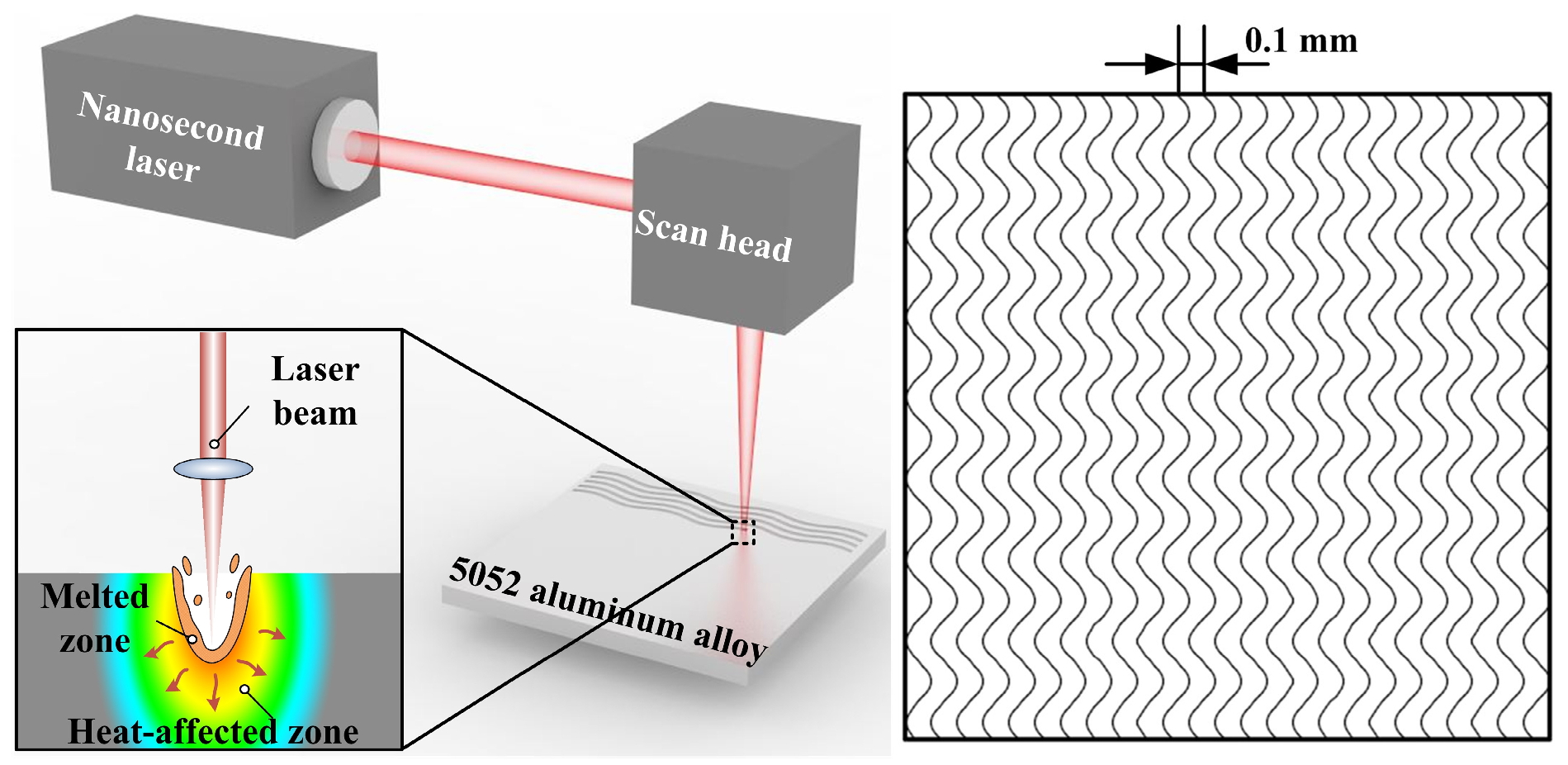
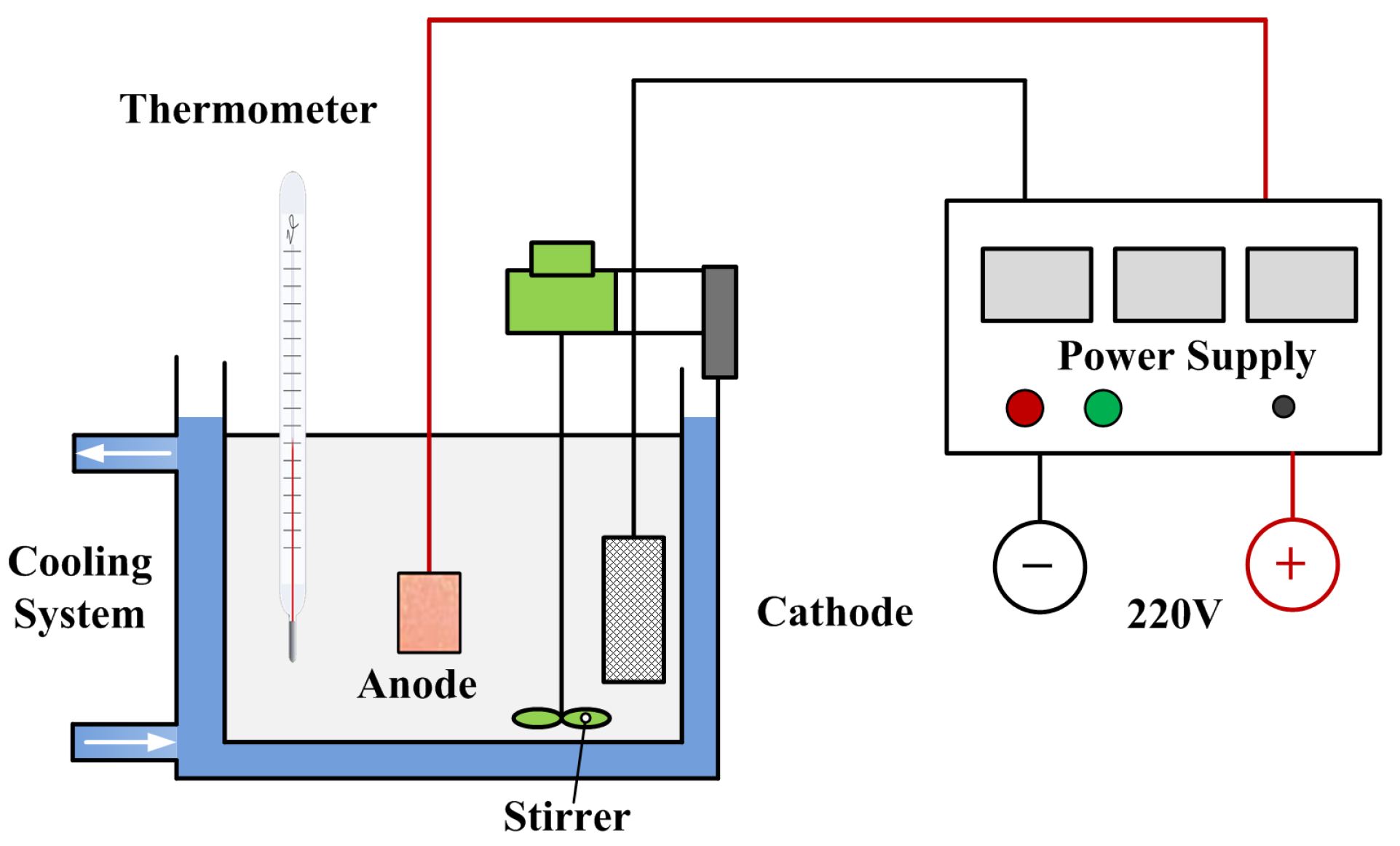

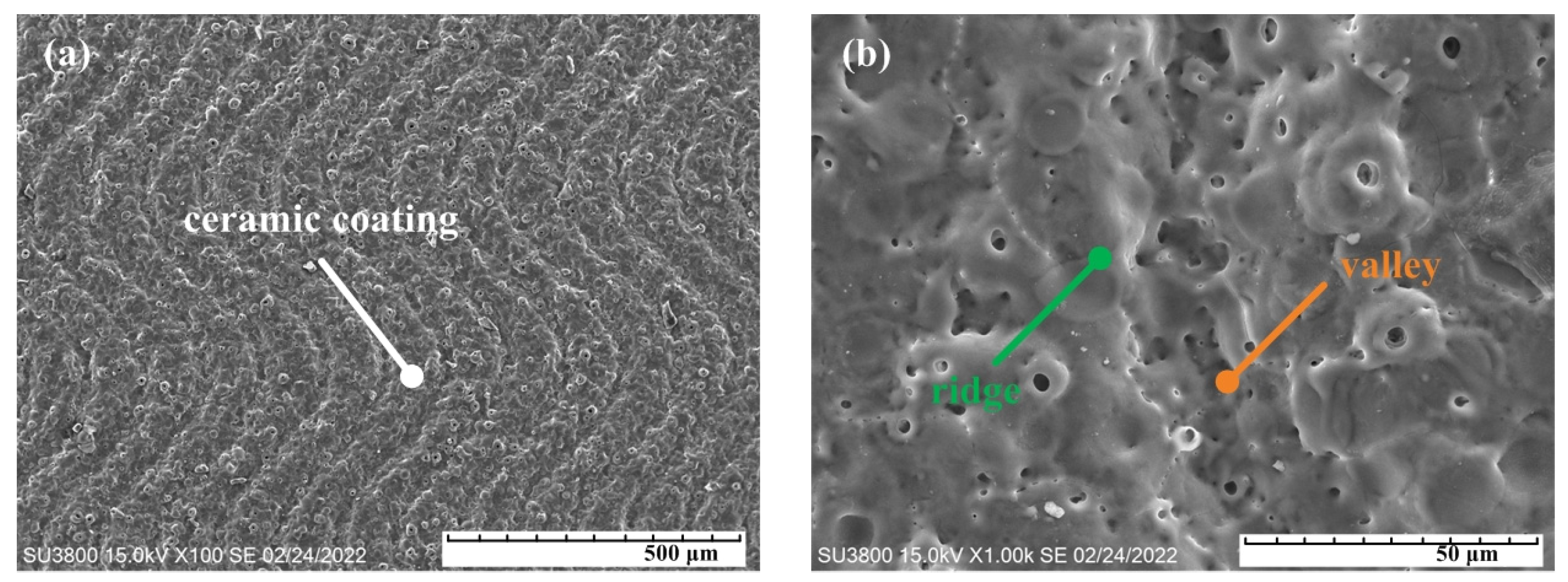
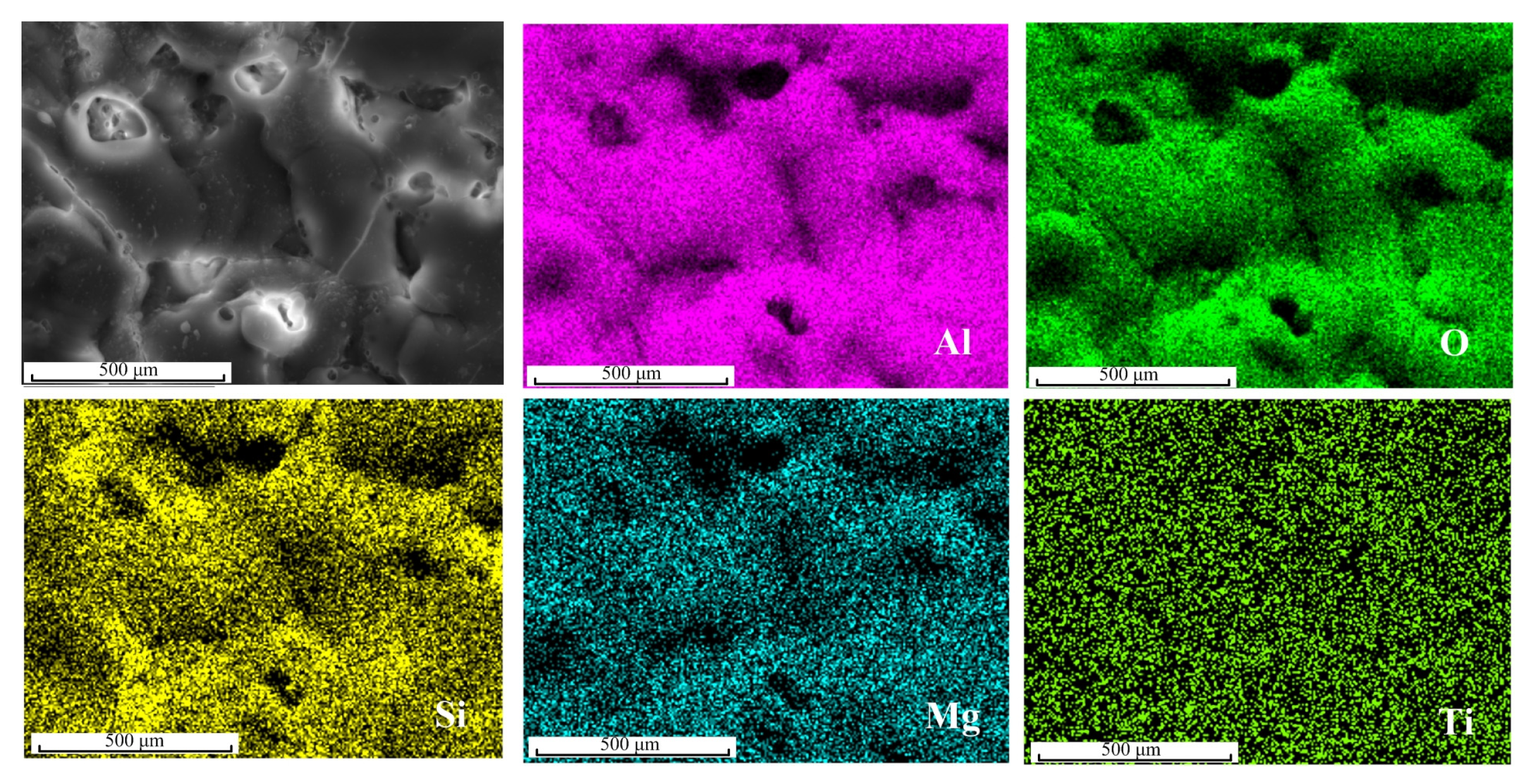
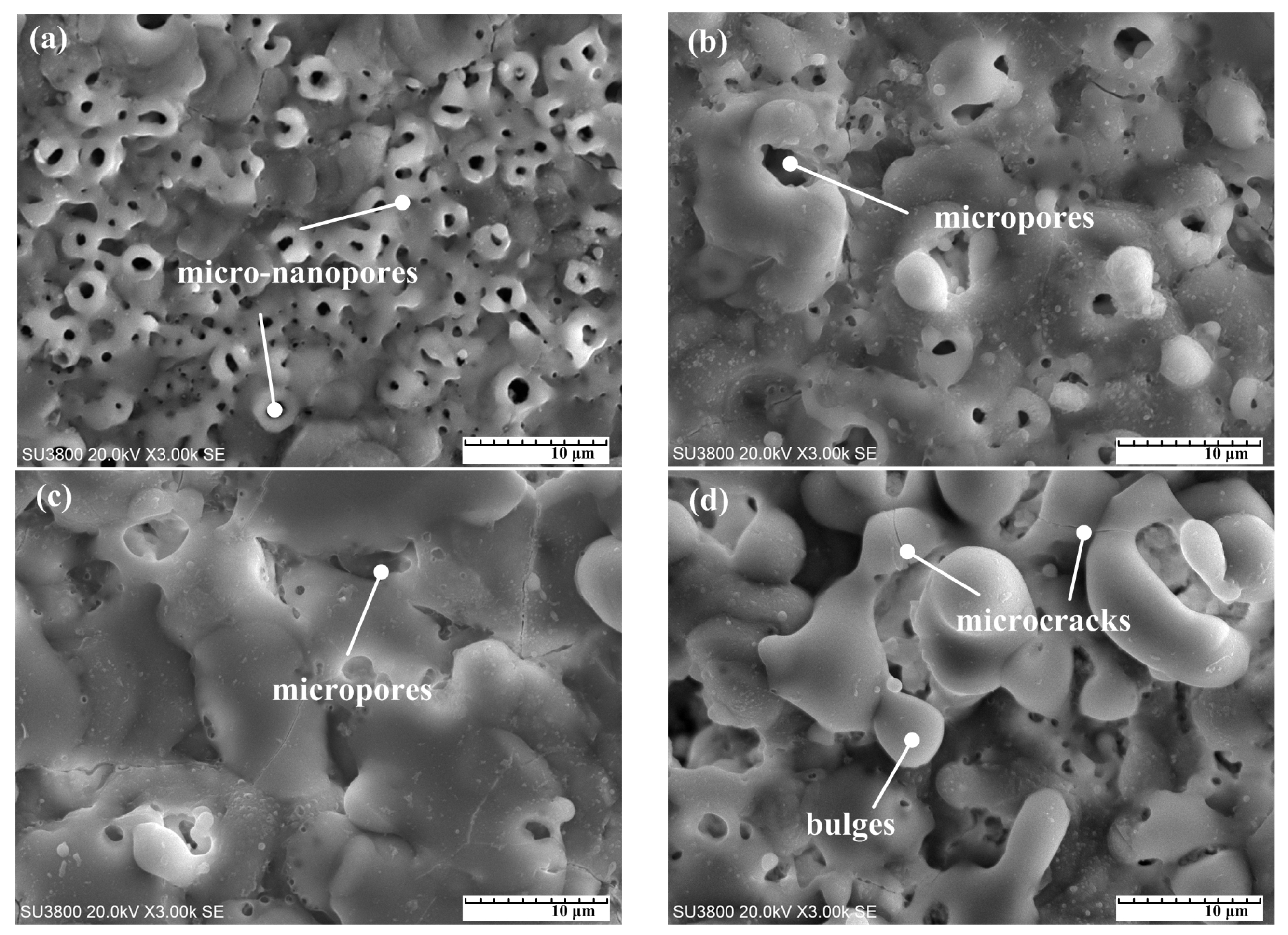
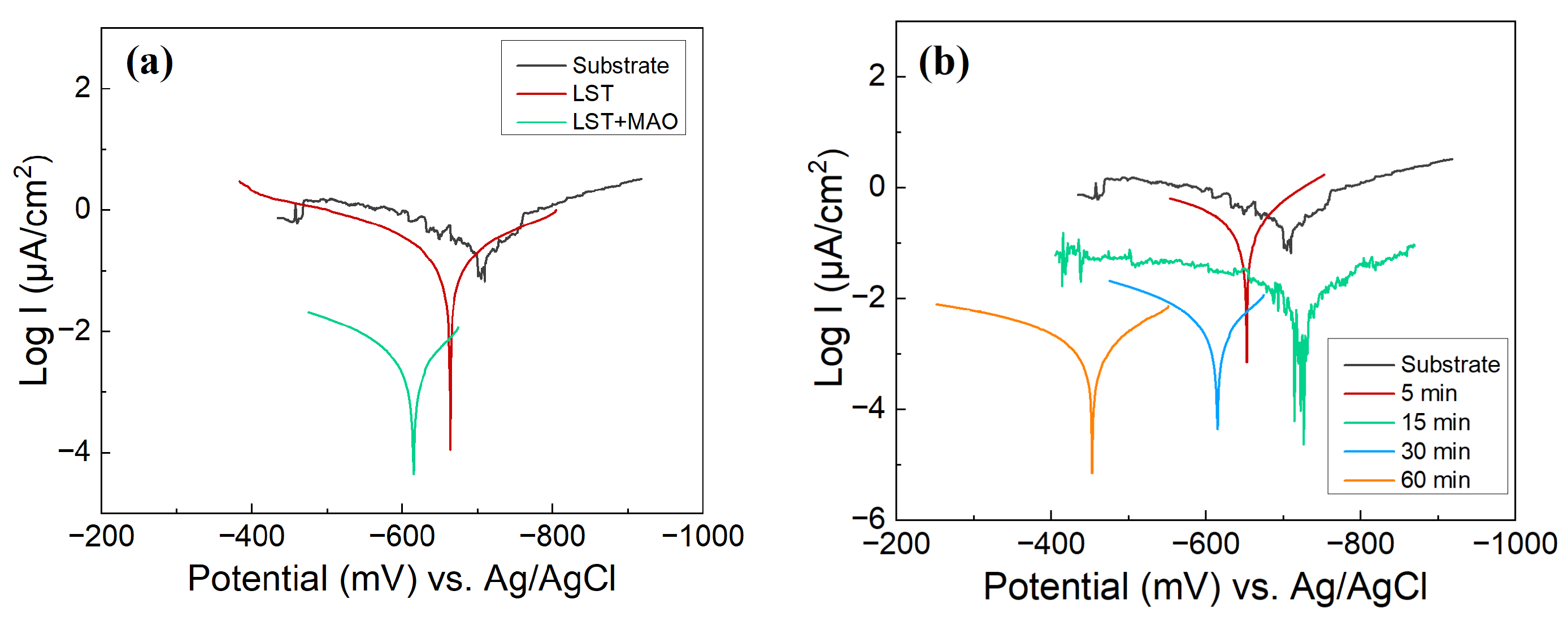
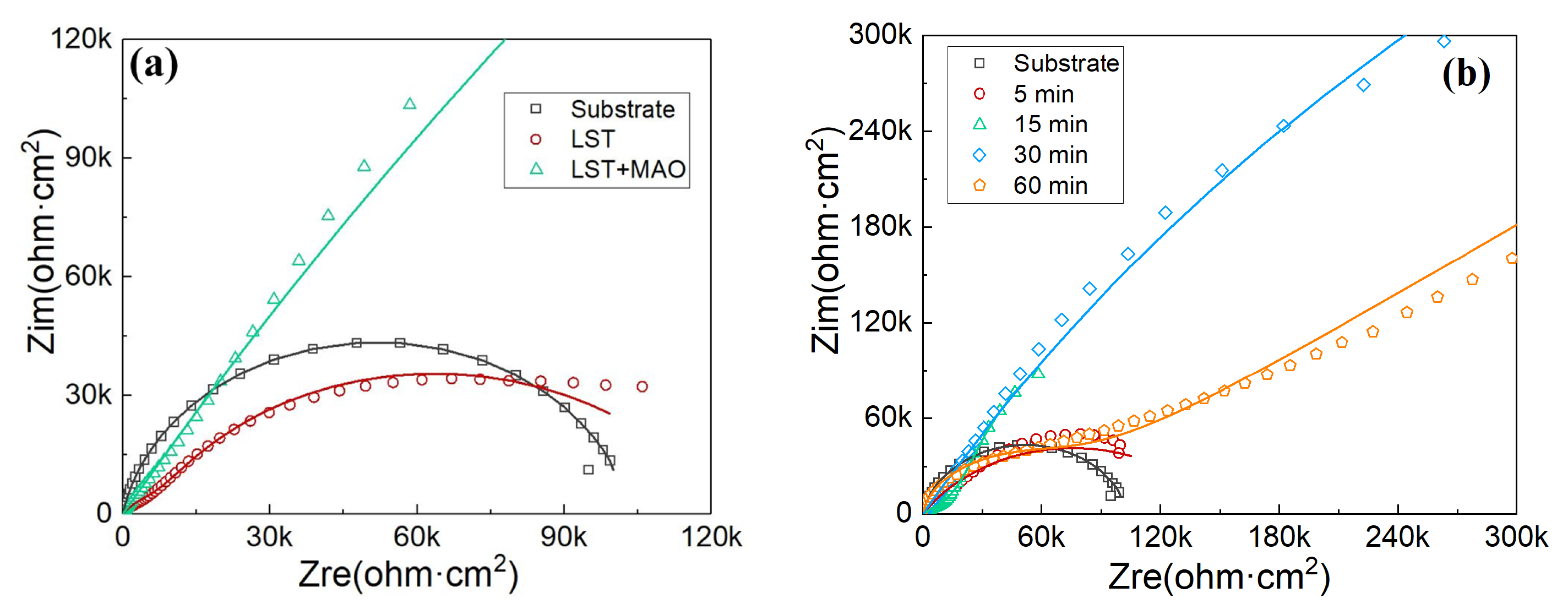

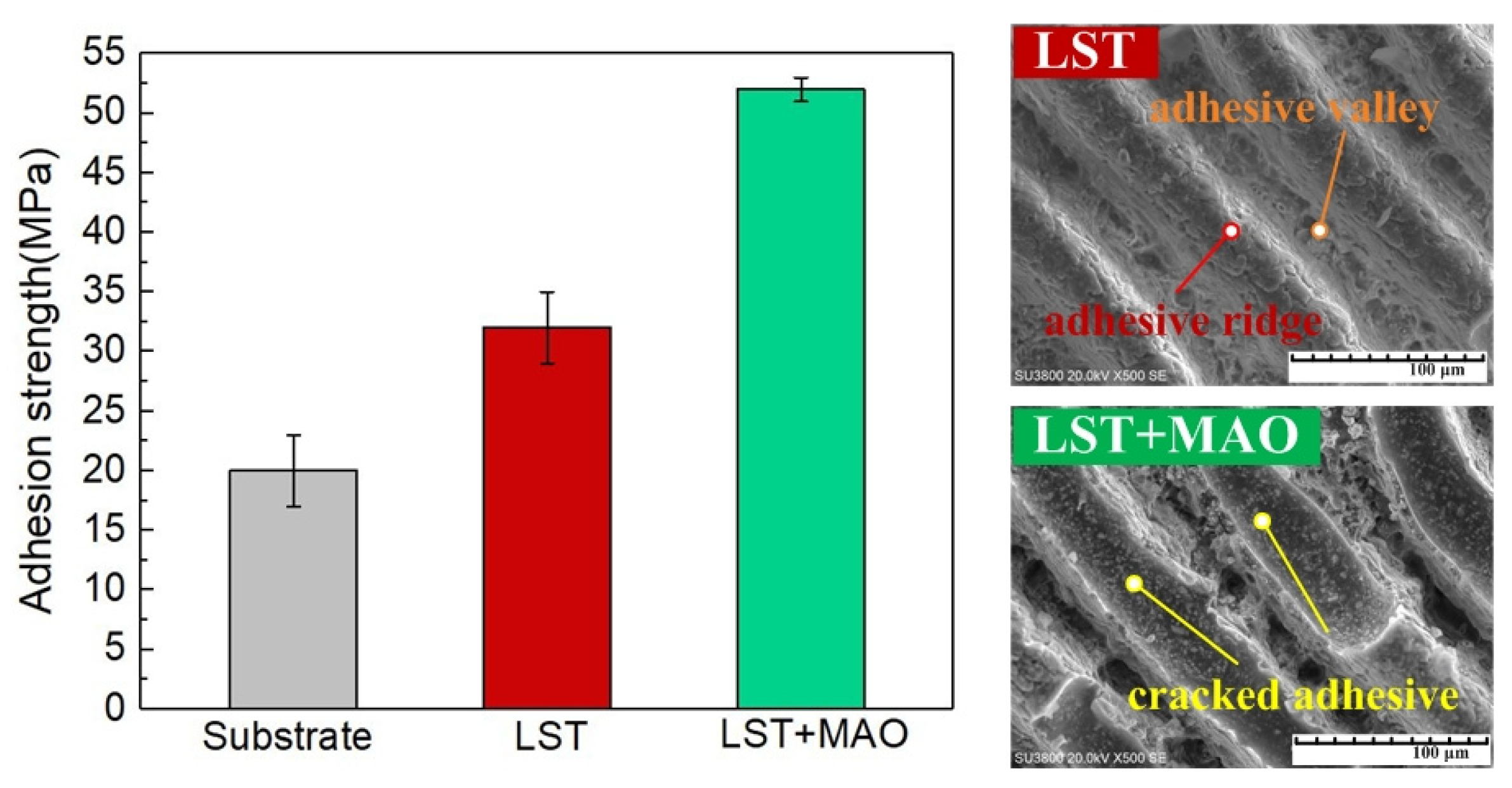
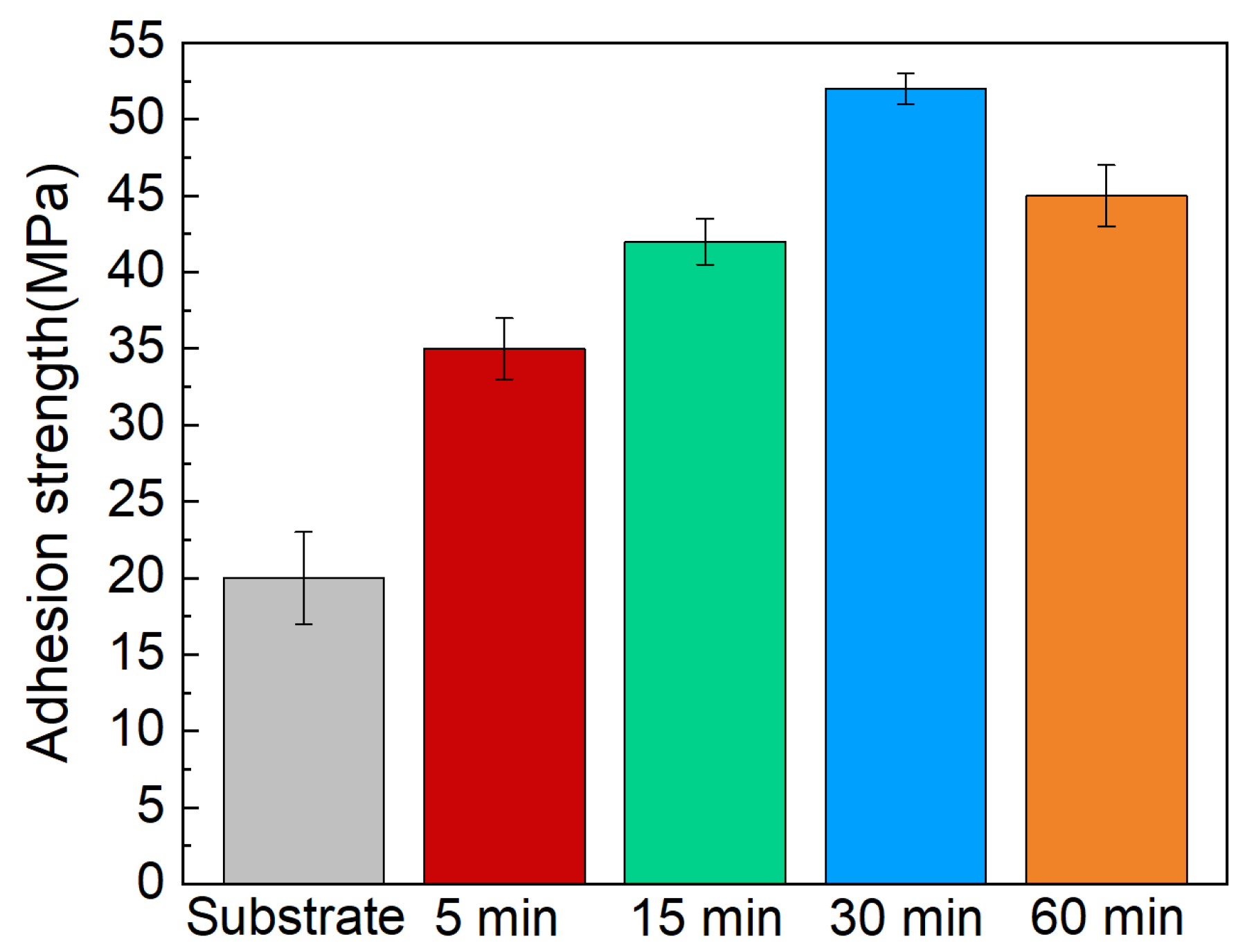
| Element | Si | Fe | Cu | Mn | Mg | Cr | Zn | Al |
|---|---|---|---|---|---|---|---|---|
| Content | 0.06 | 0.21 | 0.01 | 0.01 | 2.66 | 0.19 | 0.01 | Bal. |
| No. | Surface Treatment | MAO Voltage (V) | MAO Time (min) |
|---|---|---|---|
| 1 | As-received | - | - |
| 2 | LST | - | - |
| 3 | LST + MAO | 500 | 30 |
| 4 | LST + MAO | 500 | 5 |
| 5 | LST + MAO | 500 | 15 |
| 6 | LST + MAO | 60 | 60 |
| Elements | Al | O | Si | Mg | Ti |
|---|---|---|---|---|---|
| content | 43.79 | 41.20 | 5.81 | 4.51 | 3.75 |
| Surface Treatment | Adhesion Strength (MPa) |
|---|---|
| As-received | 20 ± 3 |
| Sandblasting | 30 ± 1.5 |
| LST | 33 ± 3 |
| Sandblating + MAO | 46 ± 1.5 |
| LST + MAO | 52 ± 1 |
Disclaimer/Publisher’s Note: The statements, opinions and data contained in all publications are solely those of the individual author(s) and contributor(s) and not of MDPI and/or the editor(s). MDPI and/or the editor(s) disclaim responsibility for any injury to people or property resulting from any ideas, methods, instructions or products referred to in the content. |
© 2023 by the authors. Licensee MDPI, Basel, Switzerland. This article is an open access article distributed under the terms and conditions of the Creative Commons Attribution (CC BY) license (https://creativecommons.org/licenses/by/4.0/).
Share and Cite
Fan, C.; Wang, X.; Yin, X.; Huang, W.; Da, Y.; Jiang, H.; Cao, J.; Gai, Y.; Zhang, W. Adhesion Strength and Anti-Corrosion Performance of Ceramic Coating on Laser-Textured Aluminum Alloy. Coatings 2023, 13, 2098. https://doi.org/10.3390/coatings13122098
Fan C, Wang X, Yin X, Huang W, Da Y, Jiang H, Cao J, Gai Y, Zhang W. Adhesion Strength and Anti-Corrosion Performance of Ceramic Coating on Laser-Textured Aluminum Alloy. Coatings. 2023; 13(12):2098. https://doi.org/10.3390/coatings13122098
Chicago/Turabian StyleFan, Changfeng, Xue Wang, Xiaoli Yin, Wei Huang, Yujie Da, Hao Jiang, Jingfeng Cao, Yongchao Gai, and Wangwang Zhang. 2023. "Adhesion Strength and Anti-Corrosion Performance of Ceramic Coating on Laser-Textured Aluminum Alloy" Coatings 13, no. 12: 2098. https://doi.org/10.3390/coatings13122098




